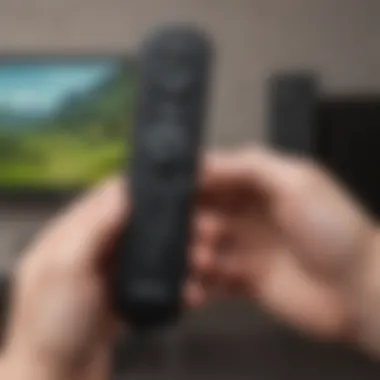Understanding the Nintendo Wiimote: A Comprehensive Analysis


Intro
The Nintendo Wiimote, also known as the Wii Remote, is a unique gaming controller that has reshaped how players interact with video games since its release in 2006. It incorporates motion sensing technology, enabling a level of interaction previously unseen in console gaming. As part of the Wii console system, the Wiimote aims not only to attract hardcore gamers but also to engage a broader audience, including families and casual players.
This analysis will dissect the Wiimote's construction, functionality, and lasting impact on the gaming landscape. The discussion will cover important elements such as its design philosophy, technology, and the cultural shifts it brought about in the gaming sector. By scrutinizing these areas, this article aims to present a deep understanding of the Wiimote and its relevance in gaming history.
Prelude to the Nintendo Wiimote
The Nintendo Wiimote, also known as the Wii Remote, is more than just a gaming accessory. Its significance extends beyond mere functionality; it represented a shift in how people engage with video games. Designed to leverage motion sensing technology, the Wiimote has fundamentally altered the landscape of interactive entertainment. This section aims to introduce the Wiimote, focusing on its pivotal role in gaming history and its impact on user experiences.
Origins and Development
The journey of the Nintendo Wiimote began in the early 2000s when Nintendo sought to create a more engaging interface for their gaming console, the Wii. Unlike traditional controllers that rely on buttons and analog sticks, the Wiimote was designed to be intuitive and user-friendly. The idea was to appeal to a broader audience, including those who may have felt alienated by more complex gaming systems. Shigeru Miyamoto, a prominent figure in Nintendo's history, envisioned a controller that could bridge generations and invite everyone into the gaming community.
Development of the Wiimote involved extensive research into motion sensing technology. Nintendo collaborated with multiple engineers to refine their prototype, ensuring the controller could accurately detect and translate players' movements into the game. During this phase, challenges included maximizing the user experience while minimizing latency. The initiative resulted in a revolutionary device that emphasized physical interaction over traditional button presses, marking a crucial step in gaming advancements.
Market Preamble and Reception
The Wii console, and its bundled Wiimote, was released in November 2006. From the start, market reception was overwhelmingly positive. Critics praised the innovative approach to gameplay, which allowed users to swing, point, and move in ways never previously experienced. The groundbreaking nature of the Wiimote attracted attention not just from gamers but also from completely new audiences, showing that gaming could be a family-friendly activity.
Sales figures highlighted the Wiimote’s success. By early 2007, sales of the Wii console reached unprecedented heights, indicating a strong endorsement from the market. Gamers and non-gamers alike recognized the value of the Wiimote's unique features, enhancing both playability and accessibility. Consumer excitement translated into sales, solidifying the Wii’s position in a competitive industry.
In summary, the Nintendo Wiimote represents a significant evolution in gaming design and culture. By shifting focus from conventional controls to a more immersive experience, the Wiimote paved the way for future gaming technologies, establishing a legacy that continues to influence game development today.
Technical Specifications of the Wiimote
The Nintendo Wiimote is a remarkable device with many technical specifications that set it apart from traditional gaming controllers. Understanding these specifications is crucial for grasping how the Wiimote transformed gaming interactions. This section brings attention to its design, sensors, and connectivity features. Each element provides valuable insights into the controller's advantages, as well as the challenges it faces.
Design and Ergonomics
The design of the Wiimote is central to its usability and appeal. Shaped like a remote control, it fits comfortably in the hands of players. This ergonomic approach minimizes fatigue during long gaming sessions. The controller has a simple layout of buttons, making it intuitive for users of all ages.
There is a wrist strap attached to prevent accidental drops. This feature highlights Nintendo’s awareness of player safety. Furthermore, the two-part design allows for easy access to the battery compartment. It also maintains a lightweight nature which is essential for extended periods of motion-based gameplay.
Sensors and Motion Detection
The Wiimote incorporates advanced sensors that are key to its functionality. It uses a combination of accelerometers and infrared sensors to detect movement. This makes the Wiimote capable of registering both directional and motion input. Such technology provides a unique gaming experience compared to traditional controllers.
The infrared sensor can detect signals from the sensor bar placed on top of a television. This detection allows for precise pointing and aiming in various games. The motion-sensing technology provides an opportunity for creative gameplay. Players can swing, tilt, and rotate the controller, enhancing interaction and immersion.
"The Wiimote stands out for its unique approach to motion and sensor technology in gaming."
Power and Connectivity
Power management is another essential aspect of the Wiimote. It operates on two AA batteries, providing a decent battery life during use. Nevertheless, some users express concerns regarding the frequency of battery replacement, especially during intense gaming sessions.
For connectivity, the Wiimote pairs with the Nintendo Wii console using Bluetooth technology. This wireless connection not only reduces cable clutter but also allows for more freedom of movement during gameplay. It is capable of connecting up to four Wiimotes simultaneously, facilitating multiplayer gaming without the hindrance of wires.


In summary, the technical specifications of the Wiimote are foundational to its role as a transformative controller in the gaming industry. The design, sensor accuracy, and connectivity features collectively enhance the immersive experiences for gamers, integrating them more directly into the virtual world.
User Interaction Mechanics
User interaction mechanics are crucial when discussing the Nintendo Wiimote. They fundamentally change how players engage with video games and affect the overall user experience. This section will highlight specific elements of user interaction, the benefits of these mechanics, and their significance within the context of gaming.
Pointing and Gesture Recognition
The ability to point and recognize gestures is what distinguishes the Nintendo Wiimote from other traditional gaming controllers. The device employs an infrared sensor and a sensor bar to detect movements and positions. Players can point at the screen with exceptional precision. This capability transforms gameplay, allowing for intuitive control systems that were previously unavailable.
Users can perform various gestures, such as flicks or swings, to execute actions in games, creating a more immersive experience. The precise recognition of these gestures can lead to greater satisfaction and engagement. Games like "Wii Sports" demonstrate this interaction, as players use the Wiimote to mimic real-life sports actions.
By employing a natural and physical movement style, the Wiimote taps into the physicality that many gamers crave.
Gameplay Integration
Integrating user interaction mechanics into gameplay means rethinking how games are designed. Many developers adapted their approaches to take advantage of the Wiimote's capabilities. The device allows for innovative gameplay styles, leading to experiences that are not only entertaining but also distinct from those on other consoles.
An example of this integration can be seen in "The Legend of Zelda: Twilight Princess". Players use the Wiimote to swing the sword, aim arrows, and interact with objects in a way that feels very real. This dynamic connection between player actions and in-game responses elevates the play experience. Moreover, it encourages exploration and experimentation, as each gesture can lead to different outcomes.
Compatibility with Other Devices
The Nintendo Wiimote's compatibility with other devices adds another layer to its functionality. It can work alongside the Nintendo Nunchuk, which enhances capabilities by adding an analog stick and extra buttons. This combination enables more complex control schemes in games, making it versatile for different gaming genres.
Additionally, the Wiimote can connect with various other devices. For example, some users have experimented with using the Wiimote on computers. With the right software, it can function as an input device for various programs. This type of compatibility enriches the gaming ecosystem, allowing users to get more utility out of their controller.
The advancements in user interaction mechanics of the Wiimote opened the door for future gaming technologies, influencing how players interact across various platforms.
Impact on Gaming Culture
The Nintendo Wiimote has had a profound influence on gaming culture since its release. It introduced a new paradigm in how players interact with video games. This section will explore the essential aspects of the Wiimote's impact on gaming, highlighting its significant contributions to casual gaming, social interaction, and the crossover with fitness activities. Understanding these elements provides insight into why the Wiimote remains a crucial topic in discussions about the evolution of gaming.
Revolutionizing Casual Gaming
The Nintendo Wiimote transformed gaming into a family-friendly activity. Before its introduction, gaming primarily catered to more dedicated and serious audiences. The Wiimote, with its intuitive design and motion-based controls, appealed to casual gamers. Players of all ages found it accessible, allowing them to engage in gaming experiences without prior expertise.
Key elements of this transformation include:
- Intuitive Controls: The motion-sensing technology made it easier for beginners to understand and enjoy gameplay.
- Diverse Game Library: Titles such as Wii Sports encouraged group play, making gaming a shared experience.
- Physical Activity: The emphasis on movement attracted individuals who may not have considered gaming as an engaging pastime.
This shift has influenced game developers to consider more user-friendly approaches in game design. The Wiimote set a precedent for future game consoles, suggesting that accessibility might lead to a broader audience.
Social Interaction through Gameplay
The Wiimote's design fostered social interaction in ways previous consoles did not. Gamers could play in groups and enjoy friendly competition, creating a communal atmosphere. This was especially evident during gatherings where families and friends would participate together.
Factors to note include:
- Multiplayer Experiences: Games designed for multiple players encouraged interaction. Mario Kart Wii is an example where the competitive spirit thrives in a social context.
- Cooperative Play: Many games offered a cooperative mode, enhancing teamwork among players.
- Party Games: The emergence of party games as a popular genre marked an important cultural shift, promoting the idea that gaming can be a social event.


Thus, the Wiimote helped redefine how individuals engage with one another through video games, moving it beyond solitary experiences to foster communal enjoyment.
Crossover Between Gaming and Fitness
An interesting aspect of the Wiimote is its ability to blend gaming with physical fitness. By requiring players to move their bodies, it encouraged a more active lifestyle. This crossover appealed to those looking for ways to integrate more movement into their routines, making exercise enjoyable.
Considerations include:
- Active Gameplay: Titles like Wii Fit offered structured fitness programs, encouraging regular exercise through game mechanics.
- Increased Awareness: The emphasis on physical activity highlighted the importance of a healthy lifestyle, contributing to broader conversations about fitness and gaming.
- Fitness Communities: Online platforms emerged where players shared their fitness journeys, showcasing a community committed to both gaming and health.
In summary, the Wiimote is more than just a gaming device; it is a cultural artifact that signifies a shift towards inclusive gaming experiences, social interaction, and a healthier lifestyle. Its legacy still resonates today, influencing how games are developed and played.
Game Library Compatible with the Wiimote
The Nintendo Wiimote is not only notable for its innovative design and functionality but also for its diverse game library. A wide range of titles was developed specifically to utilize the unique capabilities of the Wiimote. This topic is essential as it highlights the device’s real-world application in gaming, influencing how players interact with games. A strong game library enhances the value of any console, and the Wiimote is no exception. Its integration with various genres showcases the potential for motion control technology.
Family-Friendly Titles
One of the most significant areas where the Wiimote shines is in family-friendly gaming. Nintendo has always prioritized inclusivity and accessibility, and the Wiimote's design complements this ethos. Titles such as "Wii Sports" and "Mario Kart Wii" serve as perfect examples. These games encourage multiplayer interaction, making them ideal for family gatherings or social events.
- Wii Sports: This game popularized the Wiimote and brought families together for active play. Players can engage in tennis, bowling, boxing, and more, enhancing physical activity.
- Mario Kart Wii: With easy controls and vibrant graphics, this game is accessible to players of all ages. The intuitive motion steering through the Wiimote allows for fun and competitive racing.
The simplicity in controls and interactive gameplay fosters a sense of camaraderie among players, promoting the idea that gaming can be both entertaining and an avenue for family bonding.
Competitive Gaming Experiences
While family-friendly titles dominate much of the Wiimote's appeal, it also presents competitive experiences. Games such as "Super Smash Bros. Brawl" and "The Legend of Zelda: Skyward Sword" not only provide engaging single-player stories, but they also offer expansive multiplayer interactions.
- Super Smash Bros. Brawl: The fast-paced action requires precision and quick reflexes. Players need to master the motion controls for ultimate skill expression. This creates highly competitive scenarios, where practice and strategy become key elements.
- The Legend of Zelda: Skyward Sword: This game incorporates motion control in combat mechanics, demanding a level of skill that sets the stage for intense challenges. Players must utilize precise movements to solve puzzles and defeat enemies.
The competitive titles demonstrate that the Wiimote is not just for casual play; it can challenge experienced gamers and provide depth and complexity.
Exceptional Titles illustrating Wiimote Capabilities
Several standout titles effectively showcase the full range of the Wiimote’s capabilities. Games like "Just Dance" and "Rayman Raving Rabbids" harness motion sensors in innovative ways.
- Just Dance: This dance rhythm game requires players to follow on-screen choreography, using the Wiimote to score points based on their movements. It's a fun way to engage with music while promoting physical engagement.
- Rayman Raving Rabbids: This game utilizes the Wiimote for mini-games that require unique motion-based inputs, pushing the boundaries of traditional gameplay in creative new directions.
These exceptional titles highlight the versatility of the Wiimote, which goes beyond typical gaming experiences. They illustrate how motion control technology can revolutionize gameplay mechanics.
Critiques and Limitations of the Wiimote
The Nintendo Wiimote’s launch created a stir in the gaming world, yet it is not without its critiques and limitations. These aspects are essential to understanding the impact of the device. While the Wiimote introduced innovative features, addressing its shortcomings helps to appreciate its overall influence and guides future developments in gaming technology.
Accuracy Issues
One prominent critique of the Wiimote is its accuracy in motion detection. Designed to deliver immersive gameplay, it often struggled to track movements precisely. Users reported frequent inconsistencies, particularly when used in environments with poor lighting or from angles not aligned with the sensor bar. This sensitivity to external conditions meant that not every player experienced the same level of performance.


Inaction-heavy titles such as The Legend of Zelda: Skyward Sword showcased the technological limitations effectively. Players experienced frustration due to misinterpretations of subtle movements or gestures. Additionally, in comparison to contemporary gaming controllers featuring advanced precision, the Wiimote fell short in delivering the same responsiveness expected by many gamers today. Keeping these limitations in mind is essential for a balanced view of the device's contributions to gaming.
Durability Concerns
Another limitation pertains to the durability of the Wiimote. The design intended for interactive play offered comfort and an engaging experience, but this came at a cost. Frequent usage often led to wear and tear, evident in the device's physical components. Reports emerged of broken or non-responsive buttons and issues with the wrist strap securing the controller during vigorous movements.
Enthusiastic players performing energetic actions in sports and party games sometimes experienced accidents that resulted in damages not covered under warranty. Furthermore, the need to constantly replace batteries raised concerns about the sustainability of using the Wiimote long-term. To mitigate these concerns, many gamers resorted to third-party accessories designed to enhance the durability and functionality of the original product.
"While the Nintendo Wiimote introduced groundbreaking concepts, its limitations remind us of the constant evolution within gaming technology."
Understanding the critiques and limitations of the Wiimote provides insight into both its historical significance and its impact on subsequent controller designs. Each of these elements shapes the conversation around user experience and interaction in the gaming world, paving the way for innovation in gaming interfaces.
Legacy and Influence
The Nintendo Wiimote represents a significant milestone in the evolution of gaming technology. Its legacy extends beyond just hardware; it reshaped the approach to player interaction and engagement in video games. Understanding this legacy is vital for both gamers and industry professionals, as it highlights the trajectory of innovation in gaming interfaces.
Inspiration for Future Controllers
The design and functionality of the Wiimote have inspired many subsequent gaming devices. By integrating motion sensing and unique controls into gameplay, the Wiimote set a precedent for how players interact with video games. Companies such as Sony and Microsoft adopted similar principles in their later consoles and accessories. For instance, the PlayStation Move and Microsoft Kinect reflect the influence of the Wiimote's motion control capabilities. The Wiimote's unique ability to translate physical movements into digital actions has paved the way for more immersive and interactive gameplay experiences.
Some specific advancements inspired by the Wiimote include:
- Motion Sensing: Many modern controllers feature advanced motion detection that enhances gameplay.
- Gesture Recognition: The idea of using gestures to command in-game actions has become standard in various gaming systems.
- Interactive Environments: Games now often encourage players to engage with their surroundings more dynamically, influenced by the Wiimote’s approach to user interaction.
In summary, the Wiimote's innovations have set off a ripple effect within the gaming industry, driving the development of new technologies and encouraging a more engaging gaming experience.
Continued Relevance in Modern Gaming
Even as technology progresses, the relevance of the Wiimote continues to endure. The fundamental principles of motion control and interactive gameplay it introduced remain highly influential in modern gaming. Many current game titles execute mechanics that echo the core functions of the Wiimote.
For example, games that use controllers with motion capabilities often borrow ideas from how the Wiimote utilized wrist movements and pointing actions to add depth to game mechanics. Furthermore, the rise in virtual reality platforms has also seen a return to similar interactive designs that prioritize user movement and physical interaction.
Key considerations regarding the Wiimote's relevance include:
- Cross-Platform Compatibility: Various game platforms now accommodate motion controls, building on concepts pioneered by the Wiimote.
- Evolving Game Genres: Fitness and educational games continue to thrive, emphasizing movement, which can be traced back to the Wiimote's early influence.
- User Engagement: Interactive gameplay, seen as a standard feature today, stems from the engaging methods that the Wiimote introduced.
Overall, the Wiimote's approach to gameplay continues to resonate, reminding the industry of the importance of creating engaging, interactive, and user-friendly gaming experiences.
Culmination
The conclusion serves as a pivotal element in synthesizing the comprehensive analysis of the Nintendo Wiimote. It encapsulates findings while emphasizing the console's contribution to the gaming landscape. A strong conclusion reflects on key insights discussed throughout the article, ensuring the reader grasps the core themes with clarity. This section not only summarizes main points but also highlights the broader implications of the Wiimote in gaming evolution.
Summation of Insights
The Nintendo Wiimote introduced a paradigm shift in gameplay mechanics, merging traditional gaming with motion technology. Its intuitive design and interactive capabilities enabled an immersive experience previously unseen in console gaming. The article examined the user interaction mechanics, illustrating how players could engage physically with their favorite titles. By presenting a blend of pointing, gestures, and intuitive controls, the Wiimote allowed for diverse gameplay that attracted a wider audience, including non-gamers.
Moreover, we discussed its game library, showcasing titles that highlighted its strengths, from family-friendly games to competitive experiences. The assessment of the device's critiques offered a balanced view, acknowledging limitations without overshadowing its innovative spirit. For instance, while accuracy issues presented challenges, they did not diminish the overall impact the controller had on gameplay. Understanding these insights provides an appreciation for the complexities of gaming evolution and sets the stage for recognizing future advancements in interactive gaming.
Final Thoughts on Evolution of Gaming Interfaces
The journey of gaming interfaces continues to evolve, and the Nintendo Wiimote stands as a significant milestone in that journey. Its introduction foreshadowed the emergence of increasingly sophisticated interaction methods. As gaming technology advances, the lessons gleaned from the Wiimote's integration of motion detection and control will influence future designs. While newer interfaces may be more refined, the foundation laid by the Wiimote remains essential in understanding user engagement.
Furthermore, with VR and AR technologies gaining traction, the principles first operationalized through the Wiimote are more relevant than ever. As the gaming industry observes the trajectory of player interaction, it can draw from the successes and failures of past innovations like the Wiimote. Therefore, appreciating the Wiimote's legacy is crucial for industry professionals and gamers alike, encouraging a deeper comprehension of how past technology shapes future developments in gaming interfaces.



